Introduction Infant mortality has become a major concern
Added on 2022-12-27
17 Pages3664 Words84 Views
Introduction
Infant mortality has become a major concern worldwide. The human rights activist are always in
the race in ensuring that child mortality has been reduced. It's so sad when women are expectant
for a period of nine months and then the kid pass away during delivery. Infant mortality is the
number of child death under the age of one per thousand live births [3]. The death of infants is
caused by various problems. Infant mortality at times is associated with maternal death which is
worse. Nurses argue that it is better to save one life rather than letting to lives pass away. This
was validated by the United Nations high commission for children and refugees when they
released a report saying that annually 100865 mothers died during delivery, and they said it was
better for nurses and midwives to consider reducing those number of deaths by trying to save the
infant as well as the mothers [7].
Mostly, the death of children under the age of one arises due to complications during child
delivery, where a mother who expected to deliver a child in the normal way has to undergo a
caesarian delivery. Further, improper medical checkup has also been a major cause of child
mortality. The world health organization released a report the end of last year indicating that
most infant mortality was calling in developing countries and in particular sub-Saharan Africa
and Asian countries [3, 5]. The report showed that fifty percent of the infant mortality was from
those regions. This has led to the introduction of campaigns by the non-governmental
organizations in those regions where they campaign how they can save infants and mothers
during child delivery.
Due to this, a study was conducted to investigate how infant mortality is related to countries in
various regions.
Infant mortality has become a major concern worldwide. The human rights activist are always in
the race in ensuring that child mortality has been reduced. It's so sad when women are expectant
for a period of nine months and then the kid pass away during delivery. Infant mortality is the
number of child death under the age of one per thousand live births [3]. The death of infants is
caused by various problems. Infant mortality at times is associated with maternal death which is
worse. Nurses argue that it is better to save one life rather than letting to lives pass away. This
was validated by the United Nations high commission for children and refugees when they
released a report saying that annually 100865 mothers died during delivery, and they said it was
better for nurses and midwives to consider reducing those number of deaths by trying to save the
infant as well as the mothers [7].
Mostly, the death of children under the age of one arises due to complications during child
delivery, where a mother who expected to deliver a child in the normal way has to undergo a
caesarian delivery. Further, improper medical checkup has also been a major cause of child
mortality. The world health organization released a report the end of last year indicating that
most infant mortality was calling in developing countries and in particular sub-Saharan Africa
and Asian countries [3, 5]. The report showed that fifty percent of the infant mortality was from
those regions. This has led to the introduction of campaigns by the non-governmental
organizations in those regions where they campaign how they can save infants and mothers
during child delivery.
Due to this, a study was conducted to investigate how infant mortality is related to countries in
various regions.

Parameters and sample population
The dataset used in this study contains five parameters that are to be investigated and 105
observations. The description of the parameters is presented in the table below
Variable label Variable description
Country Countries under the study
Income Per-capita income in us dollars
Infant Infant-mortality rate per 1000 live births
Region Regions of countries in the world: Africa, the
Americas, Asia, Europe
Oil Oil exporting country labeled as yes or no
The variable labels were used throughout when carrying out the analysis, except where there
were description and explanation of the results. The dataset had only two continuous variables,
that is an infant and per capita income, oil and region parameters were categorical variables with
the levels specified in the above table. The sample dataset used in this study was by simple
random sampling. This was first done by considering the four regions under study and then
randomly selecting the sample from there. Simple random sampling was preferred over other
sampling techniques due to its convenience [5]. Additionally, data analysis using simple random
sampling is the simplest and further it saves time and cost. The sample was selected randomly to
ensure that every country in the region had a chance to be represented in the sample. Random
sampling ensuring that the population estimates are unbiased. This ensures that the conclusion
drawn from the sample data represents the population of study fully and the decision made based
The dataset used in this study contains five parameters that are to be investigated and 105
observations. The description of the parameters is presented in the table below
Variable label Variable description
Country Countries under the study
Income Per-capita income in us dollars
Infant Infant-mortality rate per 1000 live births
Region Regions of countries in the world: Africa, the
Americas, Asia, Europe
Oil Oil exporting country labeled as yes or no
The variable labels were used throughout when carrying out the analysis, except where there
were description and explanation of the results. The dataset had only two continuous variables,
that is an infant and per capita income, oil and region parameters were categorical variables with
the levels specified in the above table. The sample dataset used in this study was by simple
random sampling. This was first done by considering the four regions under study and then
randomly selecting the sample from there. Simple random sampling was preferred over other
sampling techniques due to its convenience [5]. Additionally, data analysis using simple random
sampling is the simplest and further it saves time and cost. The sample was selected randomly to
ensure that every country in the region had a chance to be represented in the sample. Random
sampling ensuring that the population estimates are unbiased. This ensures that the conclusion
drawn from the sample data represents the population of study fully and the decision made based

on such results will be beneficial. During the analysis, the parameter labeled country was not
used. This was because it was used as the unique identifier of the variables in the dataset.
Collected data
The study about the infant mortality was studied using dataset obtained from
http://vincentarelbundock.github.io/Rdatasets/datasets.html. This meant that the data used in the
analysis was secondary data. The data was obtained from the inline site above because its free
source and also the data from that site has been verified for use among students [1, 3]. Therefore,
it was cost effective to use the secondary data as it also saved much time which could have been
used in collecting raw data from the hospitals. The infant mortality rate per 1000 live births
(infant) will be used as the study variable in this paper. The explanatory variables used in the
study are the region, country, and oil. The objective of the study is to investigate how infant
mortality differs in various regions, whether there is any relationship between the per capita
income and the infant mortality rate. Finally, to investigate the association between the countries
that produce oil.
Descriptive statistics
Overall descriptive statistics were performed for the continuous variables in the dataset and
below is the excel output of the descriptive statistics.
income Infant
Mean 998.066666
7
Mean 85.6552381
Median 334 Median 59.6
Mode 100 Mode 0
used. This was because it was used as the unique identifier of the variables in the dataset.
Collected data
The study about the infant mortality was studied using dataset obtained from
http://vincentarelbundock.github.io/Rdatasets/datasets.html. This meant that the data used in the
analysis was secondary data. The data was obtained from the inline site above because its free
source and also the data from that site has been verified for use among students [1, 3]. Therefore,
it was cost effective to use the secondary data as it also saved much time which could have been
used in collecting raw data from the hospitals. The infant mortality rate per 1000 live births
(infant) will be used as the study variable in this paper. The explanatory variables used in the
study are the region, country, and oil. The objective of the study is to investigate how infant
mortality differs in various regions, whether there is any relationship between the per capita
income and the infant mortality rate. Finally, to investigate the association between the countries
that produce oil.
Descriptive statistics
Overall descriptive statistics were performed for the continuous variables in the dataset and
below is the excel output of the descriptive statistics.
income Infant
Mean 998.066666
7
Mean 85.6552381
Median 334 Median 59.6
Mode 100 Mode 0

Standard
Deviation
1416.71429
4
Standard
Deviation
90.67081943
Skewness 1.80460478
4
Skewness 2.980820958
Range 5546 Range 650
Minimum 50 Minimum 0
Maximum 5596 Maximum 650
Largest(1) 5596 Largest(1) 650
Smallest(1) 50 Smallest(1) 0
Considering the descriptive statistics for the infant mortality rate first. It had an average of 85.66
this indicated that most infant mortality reported was around 85.66 per 1000 live births. It had a
skewness of 2.9808 which indicated that the infant mortality rate was positively skewed. The
skewness being 2.98 indicated that there were more deaths in certain regions than expected. It
had a range of 650 which indicated that there was too much difference between the smallest
infant mortality rate and the highest infant mortality rate. This implied that more regulation n
were needed to minimize the high number of infant mortality [4]. The infant parameter had a
standard deviation of 90.67 which indicated that most observations were spread 90.67 times
about the mean which meant that there was much spread of the observations in the dataset.
The descriptive statistics for the per-capita income has been interpreted as follows. It had a mean
of 998.07 this indicated that most of the observations were about 998.07. it had a standard
deviation of 1416.71 this was provided evidence that there was too much spread of the
Deviation
1416.71429
4
Standard
Deviation
90.67081943
Skewness 1.80460478
4
Skewness 2.980820958
Range 5546 Range 650
Minimum 50 Minimum 0
Maximum 5596 Maximum 650
Largest(1) 5596 Largest(1) 650
Smallest(1) 50 Smallest(1) 0
Considering the descriptive statistics for the infant mortality rate first. It had an average of 85.66
this indicated that most infant mortality reported was around 85.66 per 1000 live births. It had a
skewness of 2.9808 which indicated that the infant mortality rate was positively skewed. The
skewness being 2.98 indicated that there were more deaths in certain regions than expected. It
had a range of 650 which indicated that there was too much difference between the smallest
infant mortality rate and the highest infant mortality rate. This implied that more regulation n
were needed to minimize the high number of infant mortality [4]. The infant parameter had a
standard deviation of 90.67 which indicated that most observations were spread 90.67 times
about the mean which meant that there was much spread of the observations in the dataset.
The descriptive statistics for the per-capita income has been interpreted as follows. It had a mean
of 998.07 this indicated that most of the observations were about 998.07. it had a standard
deviation of 1416.71 this was provided evidence that there was too much spread of the

End of preview
Want to access all the pages? Upload your documents or become a member.
Related Documents
Malaria in Africa: A systematic Review of its Environmental Determinantslg...
|10
|2679
|59
